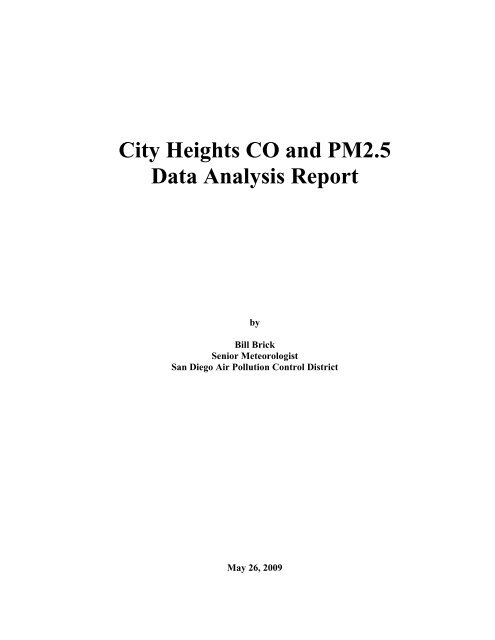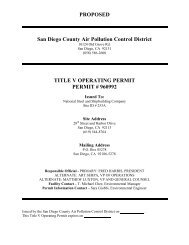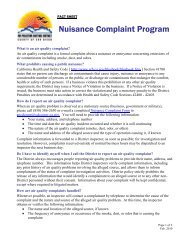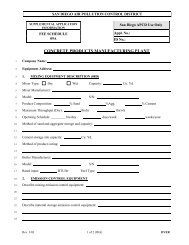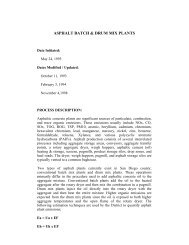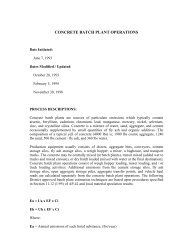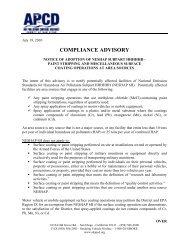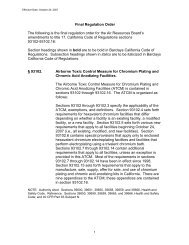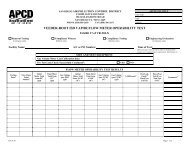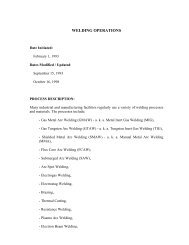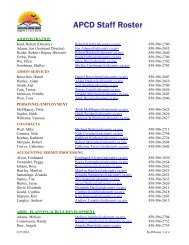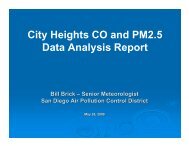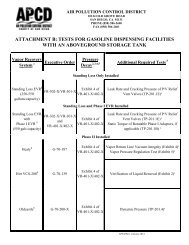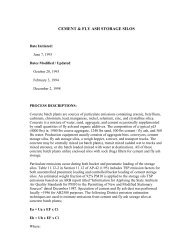City Heights CO and PM2.5 Data Analysis Report - Air Pollution ...
City Heights CO and PM2.5 Data Analysis Report - Air Pollution ...
City Heights CO and PM2.5 Data Analysis Report - Air Pollution ...
You also want an ePaper? Increase the reach of your titles
YUMPU automatically turns print PDFs into web optimized ePapers that Google loves.
THIS PAGE INTENTIONALLY LEFT BLANK
ACKNOWLEDGEMENTSThe successful monitoring of carbon monoxide <strong>and</strong> <strong>PM2.5</strong> in <strong>City</strong> <strong>Heights</strong> was accomplishedby the efforts of numerous organizations <strong>and</strong> individuals. The District acknowledges theefforts of the following individuals (<strong>and</strong> all others who participated <strong>and</strong> the author failed toacknowledge).San Diego <strong>Air</strong> <strong>Pollution</strong> Control DistrictMahmood HossainMike KaszubaDavid ShinaLarry OwusuBerdine HeckmanNoel SeefeldtRobert BerarducciAdam CanterShelley GershmanSan Diego Unified School DistrictCindy Marten – Principal at Central Elementary SchoolAndy LupaBernadette Nguyen - Principal at Wilson Middle SchoolPatricia TaylorJames WattCynthia Reed-PorterGary StanfordRon DittoBrian ChussJohn BakerCALTRANSJayne DowdaRafael AmbrosiGustavo DallardaCH2M Hill (<strong>CO</strong> monitoring Consultant to CALTRANS)Mark BennettJodi LeeKirstin SkadbergAndrea White-i-
THIS PAGE INTENTIONALLY LEFT BLANK
EXECUTIVE SUMMARYAt the request of the community of <strong>City</strong> <strong>Heights</strong>, measurements of carbon monoxide (<strong>CO</strong>)<strong>and</strong> fine particulate matter (<strong>PM2.5</strong>) were made at several locations between November 2008<strong>and</strong> February 2009. The study found that <strong>CO</strong> <strong>and</strong> <strong>PM2.5</strong> levels exhibit similar patterns toother locations in the County, <strong>and</strong> that the measured concentrations fall mid-range to othersites for both pollutants.Carbon monoxide concentrations were well below all air quality st<strong>and</strong>ards during the entirestudy. The measured <strong>CO</strong> concentrations in close proximity <strong>and</strong> on both sides of SR-15 wereless than other areas of the County where population density, traffic, topography, <strong>and</strong>meteorology result in higher concentrations. <strong>City</strong> <strong>Heights</strong> is in an area with adequateventilation <strong>and</strong> without deep pockets for cold air to settle <strong>and</strong> trap pollutants in the surfacelayer. This combination of meteorology <strong>and</strong> geography contributes to good air quality in<strong>City</strong> <strong>Heights</strong>.The <strong>PM2.5</strong> data collected in <strong>City</strong> <strong>Heights</strong> exhibit similar patterns to other locations in theCounty, with the highest concentrations in <strong>City</strong> <strong>Heights</strong> mirrored by higher concentrations inother locales. This indicates a strong correlation to atmospheric conditions <strong>and</strong> regional airquality patterns; not a locally-based problem.Similar to other locations in San Diego County, the daily <strong>PM2.5</strong> average levels in <strong>City</strong><strong>Heights</strong> are strongly affected by night <strong>and</strong> morning concentrations, where atmosphericstability plays an important role in surface concentrations. During the day, when localtraffic, <strong>and</strong> therefore emissions, is highest, surface concentrations tend to be at their lowpoint in the diurnal cycle.The <strong>PM2.5</strong> measurements in <strong>City</strong> <strong>Heights</strong> are consistent with longer-term measurementsfrom other monitoring sites in San Diego County, falling mid-range between other locations.<strong>City</strong> <strong>Heights</strong> therefore meets the federal air quality st<strong>and</strong>ards for <strong>PM2.5</strong>, along with the restof San Diego County.Based upon the results of this study, no further air quality monitoring is warranted in <strong>City</strong><strong>Heights</strong>.- 1 -
PROJECT DESCRIPTIONEarly in 2008, the San Diego <strong>Air</strong> <strong>Pollution</strong> Control District (District) was contacted by amember of County Board of Supervisors Ron Roberts’ (District 4) staff regarding airpollution concerns in <strong>City</strong> <strong>Heights</strong>. This air pollution concern stemmed from the completionof State Route 15 (SR-15) through the <strong>City</strong> <strong>Heights</strong> area many years ago, <strong>and</strong> the creation ofTeralta Park, which spans over SR-15.A previous agreement with the community of <strong>City</strong> <strong>Heights</strong> <strong>and</strong> the California Department ofTransportation (CALTRANS) called for carbon monoxide (<strong>CO</strong>) monitoring at Teralta Parkfollowing completion of the park over SR-15. The <strong>City</strong> <strong>Heights</strong> community wanted thismonitoring to ensure that there were no health issues related to SR-15 at Teralta Park. <strong>CO</strong>was chosen as the pollutant to monitor as it is a relatively direct measure of pollutantsemitted from vehicles, <strong>and</strong> therefore would show potential impacts from traffic on SR-15(based on various study documents from the 1970s, 1980s, <strong>and</strong> 1990s).The District has been monitoring <strong>CO</strong> in populated areas of San Diego County since the early1970s. With the exception of the wildfires of 2003, San Diego has not violated federal airquality st<strong>and</strong>ards for <strong>CO</strong> since 1990 or the state st<strong>and</strong>ards since 1991.CALTRANS retained a local consulting firm, CH2M Hill, to conduct the <strong>CO</strong> monitoring atTeralta Park. CH2M Hill set up <strong>and</strong> operated the <strong>CO</strong> analyzer, <strong>and</strong> the District providedquality assurance/quality control (QA/QC) calibrations, weekly checks, <strong>and</strong> audits of the <strong>CO</strong>monitoring equipment during the project. The <strong>CO</strong> monitoring project is described in moredetail in reports provided to CALTRANS by CH2M Hill.In the years following completion of SR-15 through <strong>City</strong> <strong>Heights</strong> <strong>and</strong> the creation of TeraltaPark, health studies have shown that particulate matter of 2.5 microns <strong>and</strong> less in diameter(known as <strong>PM2.5</strong>) has become a pollutant of concern. The community therefore wanted the<strong>CO</strong> monitoring at Teralta Park combined with <strong>PM2.5</strong> monitoring at Central ElementarySchool. The District was tasked with providing <strong>PM2.5</strong> monitoring support for this project.As details of the monitoring program were worked out with the community group, it becameclear that the <strong>CO</strong> <strong>and</strong> <strong>PM2.5</strong> monitoring should be conducted during winter months in orderto measure the maximum air quality impact from SR-15 on the local community. Themonitoring project was therefore scheduled for November 2008 through January 2009. Withcommunity input it was also decided to split the <strong>CO</strong> monitoring between Teralta Park(southwest corner) <strong>and</strong> Central Elementary School (southeast corner of the park) in order tosee if there were any differences on the west <strong>and</strong> east sides of SR-15.The postponement of monitoring also allowed the District to obtain two, real-time <strong>PM2.5</strong>monitors (known as EBAM) <strong>and</strong> one filter-based, Federal Reference Method (FRM) <strong>PM2.5</strong>analyzer to provide more definitive measurements of <strong>PM2.5</strong> in the community of <strong>City</strong><strong>Heights</strong>. The Central Elementary School location was chosen as the location for one EBAMunit as well as the FRM. Wilson Middle School, a few blocks to the northwest, was chosenas the location for the second EBAM unit. The placement of these analyzers allowed for- 2 -
Figure 2. Wind rose for meteorological data collected at Central Elementary School –all hours for November 19, 2008, through February 4, 2009 (dates noted inwind rose result from the computer program, not the actual dates used ingenerating the plot).- 6 -
Figure 3.Morning wind rose for meteorological data collected at Central ElementarySchool – midnight through 0700 PST for November 19, 2008, throughFebruary 4, 2009.- 7 -
Figure 4.Daytime wind rose for meteorological data collected at Central ElementarySchool – 0800 through 1600 PST for November 19, 2008, through February 4,2009.- 8 -
Figure 5.Evening wind rose for meteorological data collected at Central ElementarySchool – 1700 through 2300 PST for November 19, 2008, through February 4,2009.- 9 -
Carbon Monoxide (<strong>CO</strong>)Community concerns about the <strong>CO</strong> concentrations in the Teralta Park area were the impetusfor this monitoring project in <strong>City</strong> <strong>Heights</strong>. As stated previously in the Project Description,San Diego County is in attainment of all state <strong>and</strong> federal air quality st<strong>and</strong>ards for <strong>CO</strong>. Thesest<strong>and</strong>ards are presented in Table 3.Carbon Monoxide St<strong>and</strong>ardsCalifornia St<strong>and</strong>ardsFederal St<strong>and</strong>ards1-Hour 20 ppm 35 ppm8-Hour 9.0 ppm 9 ppmTable 3.State <strong>and</strong> federal 1-hour <strong>and</strong> 8-hour ambient air quality st<strong>and</strong>ards for carbonmonoxide (<strong>CO</strong>) in parts per million (ppm).During the entire <strong>CO</strong> monitoring period the maximum 1-hour <strong>CO</strong> concentration measured atthe Teralta Park/Central Elementary School sites was 3.1 ppm (January 18, 2009, at 0000PST). The highest <strong>CO</strong> measured at all San Diego monitoring sites during the entire project,4.6 ppm, was measured at the District’s Otay Mesa site (twice, November 13, 2008, at 2300PST; <strong>and</strong> January 1, 2009, at 0400 PST).Figure 6 shows the hourly <strong>CO</strong> concentrations for all monitoring sites in San Diego Countyfor January 18, 2009 (date of highest <strong>CO</strong> in <strong>City</strong> <strong>Heights</strong> for the entire project). The datashown in this graph are for the District’s monitoring sites in Chula Vista (CVA), DowntownSan Diego (DTN – aka Perkins Elementary School), Escondido (ESC), Otay Mesa (OTM),<strong>and</strong> Teralta Park/Central Elementary School (TEP/CES). Although this graph shows thehighest <strong>CO</strong> readings for the entire project at <strong>City</strong> <strong>Heights</strong>, these data are significantly lessthan measurements at the Downtown San Diego site. This graph also shows the <strong>CO</strong> in <strong>City</strong><strong>Heights</strong> to be significantly less than at the Escondido site during the morning commute time(although the commute on a Sunday is very different than on weekdays).All health-based air quality st<strong>and</strong>ards for <strong>CO</strong> are met in <strong>City</strong> <strong>Heights</strong> (<strong>and</strong> elsewhere in SanDiego County). Table 4 presents the maximum 1-hour <strong>and</strong> project average concentrationsfor the entire monitoring period for this project. This table shows that the <strong>City</strong> <strong>Heights</strong> areahas lower <strong>CO</strong> concentrations than Downtown San Diego, Escondido, <strong>and</strong> Otay Mesa, <strong>and</strong>slightly higher concentrations than Chula Vista.- 10 -
Hourly <strong>CO</strong> <strong>Data</strong> for: Sunday, 1/18/200940.035.0<strong>CO</strong> (ppm)30.025.020.015.010.0CVADTNES<strong>CO</strong>TMTEP/CES1-Hr <strong>CO</strong> State Std1-Hr <strong>CO</strong> Federal Std5.00.0Hour (PST)Figure 6.Hourly <strong>CO</strong> concentrations for Sunday, January 18, 2009 (date of maximum1-hour <strong>CO</strong> concentration measured in <strong>City</strong> <strong>Heights</strong> during the entire project).This graph shows that the maximum <strong>CO</strong> concentrations measured in <strong>City</strong><strong>Heights</strong> were well below State <strong>and</strong> Federal st<strong>and</strong>ards. <strong>Data</strong> gaps shown in theplot are due to nightly zero/span checks.Carbon Monoxide StatisticsCVA DTN ESC OTM TEP/CES1-hour Maximum (ppm) 2.5 4.0 4.4 4.6 3.1Average (ppm) 0.7 1.0 0.9 0.9 0.8Table 4.The maximum 1-hour <strong>CO</strong> concentration measured at each monitoring site inSan Diego County during this project along with the average concentration.Although it is not necessary to further compare the data against air quality st<strong>and</strong>ards, it canbe instructive to look further at the data collected to underst<strong>and</strong> air quality conditions in <strong>City</strong><strong>Heights</strong>. All future <strong>CO</strong> plots in this report will be shown with a maximum plot value of 5.0ppm or less (without the st<strong>and</strong>ard) in order to show better detail of <strong>CO</strong> concentrations. Plotsof each day’s <strong>CO</strong> concentrations can be found in Appendix A.A plot of hourly averaged <strong>CO</strong> data for the entire project period is shown in Figure 7. Thisgraph shows how morning commutes increase ambient <strong>CO</strong> concentrations throughout SanDiego County. The morning peaks are then followed by daily minimum values in the- 11 -
daytime as surface heating helps to vertically disperse surface concentrations. Eveningvalues show a shallower increase in <strong>CO</strong> values as there is greater vertical dispersion from thewarm ground early in the evening commute hours. Additionally, the evening commutetraffic is more spread out as compared to the morning commute. The graph for all sitesshows increases in <strong>CO</strong> concentrations as contributions from home residences (e.g., furnaces<strong>and</strong> water heaters) are added to the atmosphere that is undergoing increased atmosphericstability after sunset (surface cooling).San Diego Hourly <strong>CO</strong> <strong>Data</strong> Averages by Hour:November 1, 2008, through January 30, 20092.01.81.6<strong>CO</strong> (ppm)1.41.21.00.80.60.40.20.00 1 2 3 4 5 6 7 8 9 10 11 12 13 14 15 16 17 18 19 20 21 22 23Hour (PST)CVADTNES<strong>CO</strong>TMTEP/CESFigure 7.Graph of hourly averaged <strong>CO</strong> data for the entire project period.The data for the project period when the <strong>CO</strong> analyzer in <strong>City</strong> <strong>Heights</strong> was located at thesouthwest corner of Teralta Park (TEP) is shown in Figure 8. This graph shows similardiurnal patterns at all sites in San Diego County.- 12 -
San Diego Hourly <strong>CO</strong> <strong>Data</strong> Averages by Hour:November 1, 2008, through December 13, 2008<strong>CO</strong> (ppm)2.01.81.61.41.21.00.80.60.40.20.00 1 2 3 4 5 6 7 8 9 10 11 12 13 14 15 16 17 18 19 20 21 22 23Hour (PST)CVADTNES<strong>CO</strong>TMTEPFigure 8.Graph of hourly averaged <strong>CO</strong> data for the Teralta Park (TEP) portion of theproject.The data for the project period when the <strong>CO</strong> analyzer in <strong>City</strong> <strong>Heights</strong> was located at thesouthwest corner of Central Elementary School (CES) is shown in Figure 9. Although thisgraph is similar to the earlier time period (Figure 8), the Otay Mesa site (OTM) shows lower<strong>CO</strong> concentrations. This is most likely due to lower border traffic volume during theChristmas holiday period.- 13 -
San Diego Hourly <strong>CO</strong> <strong>Data</strong> Averages by Hour:December 22, 2008, through January 30, 2009<strong>CO</strong> (ppm)2.22.01.81.61.41.21.00.80.60.40.20.00 1 2 3 4 5 6 7 8 9 10 11 12 13 14 15 16 17 18 19 20 21 22 23Hour (PST)CVADTNES<strong>CO</strong>TMCESFigure 9.Graph of hourly averaged <strong>CO</strong> data for the Central Elementary School (CES)portion of the project.The hourly averaged <strong>CO</strong> data for the Teralta Park (TEP) <strong>and</strong> Central Elementary School(CES) portions of the project are shown together in Figure 10. This graph shows that twosites are nearly identical in their diurnal patterns <strong>and</strong> overall concentrations. Minordifferences are most likely due to the different meteorological patterns during these shortmonitoring periods.- 14 -
San Diego Hourly <strong>CO</strong> <strong>Data</strong> Averages by Hour (interpolated):November 1, 2008, through January 30, 2009<strong>CO</strong> (ppm)2.22.01.81.61.41.21.00.80.60.40.20.00 1 2 3 4 5 6 7 8 9 10 11 12 13 14 15 16 17 18 19 20 21 22 23Hour (PST)TEPCESFigure 10.Graph of hourly averaged <strong>CO</strong> data for the Teralta Park (TEP) <strong>and</strong> CentralElementary School (CES) portions of the project (interpolated mode to showdata for hour 0).The data from New Year’s Eve <strong>and</strong> New Year’s Day show how changes in daily patterns ofhuman activity can impact ambient air quality concentrations. Figure 11 shows the hourly<strong>CO</strong> concentrations for New Year’s Eve (Wednesday, December 31, 2008). <strong>CO</strong>concentrations reflect the typical morning commute, with the highest concentrationsmeasured at the District’s Downtown San Diego (DTN) <strong>and</strong> Escondido (ESC) monitoringstations. The normal afternoon pattern is followed by a later than usual afternoon increase in<strong>CO</strong> concentrations. The Escondido monitoring station data show a continuous increase inevening <strong>and</strong> late night concentrations as people continue to drive their cars <strong>and</strong> home heatingsystems <strong>and</strong> fireplaces operate at later than normal hours. The later than normal peak in <strong>CO</strong>concentrations is seen at the Central Elementary School (TEP/CES) site as well. This peakcomes from local activities as well as traffic on SR-15. The traffic on SR-15 would becomposed mainly of passenger car traffic at this time, with very limited truck traffic.- 15 -
Hourly <strong>CO</strong> <strong>Data</strong> for: Wednesday, 12/31/20085.04.54.0<strong>CO</strong> (ppm)3.53.02.52.01.51.0CVADTNES<strong>CO</strong>TMTEP/CES0.50.00 1 2 3 4 5 6 7 8 9 10 11 12 13 14 15 16 17 18 19 20 21 22 23Hour (PST)Figure 11.Graph of hourly <strong>CO</strong> concentrations for New Year’s Eve, Wednesday,December 31, 2008.Hourly <strong>CO</strong> concentrations for New Year’s Day (Thursday, January 1, 2009) are shown inFigure 12. This graph shows the highest values in the early morning hours, as late nightrevelers return home in their vehicles <strong>and</strong> home heating systems remain set at highertemperatures as people are still awake during normal sleeping hours. Again, emissions arealmost entirely from personal vehicles <strong>and</strong> home-based activities, with very limited trucktraffic. The daytime <strong>and</strong> evening <strong>CO</strong> concentrations are uncharacteristically flat as normalcommute patterns <strong>and</strong> weekday activities were altered for the holiday.- 16 -
Hourly <strong>CO</strong> <strong>Data</strong> for: Thursday, 1/1/20095.04.54.0<strong>CO</strong> (ppm)3.53.02.52.01.51.0CVADTNES<strong>CO</strong>TMTEP/CES0.50.00 1 2 3 4 5 6 7 8 9 10 11 12 13 14 15 16 17 18 19 20 21 22 23Hour (PST)Figure 12. Graph of hourly <strong>CO</strong> concentrations for New Year’s Day, Thursday, January 1,2009.The above examples of holiday emissions show how human activities in San Diego Countyaffect air quality concentrations. In can also be educational to look at air quality patterns asthey relate to human activities throughout an average week. A graph of hourly averaged <strong>CO</strong>concentrations based on the day of the week for the Teralta Park (TEP) <strong>and</strong> CentralElementary School (CES) sites is shown in Figure 13. This graph shows that the weekdaymorning commutes peak at 0700 PST while the weekend morning commutes peak lower <strong>and</strong>at 0800 PST. The lowest morning commute peak is on Sunday mornings. Daytimeconcentrations are also lowest on Sundays, with day of week differences relatively small.The evening patterns show that Friday nights had the highest concentrations <strong>and</strong> Saturdaynights the lowest concentrations.- 17 -
TEP/CES <strong>CO</strong> Averages by Day of Week:November 1, 2008 through January 30, 2009<strong>CO</strong> (ppm)2.01.81.61.41.21.00.80.60.40.20.00 1 2 3 4 5 6 7 8 9 10 11 12 13 14 15 16 17 18 19 20 21 22 23Hour (PST)MonTueWedThuFriSatSunFigure 13.Graph of hourly <strong>CO</strong> concentrations by day of week measured over the entiremonitoring project.The day of week pattern is a little clearer when New Year’s Eve <strong>and</strong> New Year’s Day areexcluded from the hourly averaging, as shown in Figure 14. This graph continues to showthe highest morning commute concentrations as occurring on Wednesday <strong>and</strong> Thursday,consistent with high levels of human activity during the middle of the week, <strong>and</strong> the highestnighttime concentrations on Friday nights, as people start their weekends <strong>and</strong> commute in<strong>and</strong> out of town.- 18 -
TEP/CES <strong>CO</strong> Averages by Day of Week (without New Year'sEve <strong>and</strong> New Year's Day):November 1, 2008 through January 30, 2009<strong>CO</strong> (ppm)2.01.81.61.41.21.00.80.60.40.20.00 1 2 3 4 5 6 7 8 9 10 11 12 13 14 15 16 17 18 19 20 21 22 23Hour (PST)MonTueWedThuFriSatSunFigure 14.Graph of hourly <strong>CO</strong> concentrations by day of week measured over the entiremonitoring project, excluding New Year’s Eve (a Wednesday) <strong>and</strong> NewYear’s Day (a Thursday).- 19 -
Fine Particulate Matter (<strong>PM2.5</strong>)An additional concern of the <strong>City</strong> <strong>Heights</strong> community is the concentration of fine particulatematter of 2.5 microns <strong>and</strong> less in diameter (known as <strong>PM2.5</strong>). The District proposed tomeasure <strong>PM2.5</strong> at two sites using two different sampling methods. The official method formeasuring <strong>PM2.5</strong> is a filter-based system (the Federal Reference Method, or FRM). Thissystem measures <strong>PM2.5</strong> concentrations over 24-hour periods, with the resulting data reportedin micrograms per cubic meter (µg/m3).Although this system is very accurate, the sample is an integrated sample, collected over theentire 24-hour period. Therefore, this measurement does not provide any information ondiurnal emission patterns. To address this issue, the District proposed using an instrumentknown as an EBAM. The EBAM measures hourly concentrations of <strong>PM2.5</strong>, providinginformation on diurnal patterns <strong>and</strong> concentrations.The District installed two EBAMs for this project. One EBAM was collocated with the FRMsampler at Central Elementary School. The second unit was located at Wilson MiddleSchool; a few blocks to the northwest (see Figure 1).The resulting data are then compared to the Federal 24-hour st<strong>and</strong>ard for <strong>PM2.5</strong> (there is noseparate state st<strong>and</strong>ard for 24-hour periods (see Table 5). The 24-hour <strong>PM2.5</strong> st<strong>and</strong>ard is metif the 98 th percentile of all samples is below the st<strong>and</strong>ard, averaged over three years.<strong>PM2.5</strong> St<strong>and</strong>ardsCalifornia St<strong>and</strong>ardsFederal St<strong>and</strong>ards24-Hour No separate State St<strong>and</strong>ard 35 µg/m3Annual Arithmetic Mean 12 µg/m3 15.0 µg/m3Table 5.State <strong>and</strong> federal 24-hour <strong>and</strong> annual ambient air quality st<strong>and</strong>ards for <strong>PM2.5</strong>.This study relies heavily on the continuous data collected by the EBAM units to betterunderst<strong>and</strong> air quality conditions in <strong>City</strong> <strong>Heights</strong>. It is therefore important to know how theEBAM data compare to the official FRM data (the filter-based method).The daily FRM <strong>PM2.5</strong> concentrations are plotted along with the EBAM-derived <strong>PM2.5</strong>concentrations in Figure 15. This graph shows that, overall, the two methods compared well.In general, the EBAM reported higher concentrations than the FRM, especially whenconcentrations were elevated to near or above the 24-hour st<strong>and</strong>ard.- 20 -
Central Elementary School: FRM vs. EBAMDecember 20, 2008, through January 29, 200960.050.0<strong>PM2.5</strong> (µg/m3)40.030.020.0FRMEBAM24-Hr St<strong>and</strong>ard10.00.0DateFigure 15.Graph showing the 24-hour <strong>PM2.5</strong> concentrations collected by the FRM <strong>and</strong>the EBAM at Central Elementary School from December 20, 2008, throughJanuary 29, 2009.The numerical values that generated Figure 15 are shown in Table 6 (the EBAM data forWilson Middle School are shown in Table 6 for comparison). The official, FRM data fromCentral Elementary exceeded the federal 24-hour st<strong>and</strong>ard on two days during the project.These exceedances occurred on January 1, <strong>and</strong> January 2, 2009 (42.4 µg/m3 <strong>and</strong> 38.1 µg/m3,respectively).- 21 -
DateCESFRMCESEBAMWMSEBAM12/20/2008 16.7 18.1 17.112/21/2008 27.9 28.4 30.212/22/2008 22.6 19.1 27.112/23/2008 8.2 8.1 8.412/24/2008 9.8 10.7 11.612/25/2008 5.1 5.0 7.712/26/2008 7.7 8.6 8.912/27/2008 10.1 9.7 10.212/28/2008 12.6 16.3 16.112/29/2008 9.7 12.0 14.212/30/2008 20.1 24.5 19.512/31/2008 29.0 38.3 32.01/1/2009 42.4 58.5 45.31/2/2009 38.1 37.7 30.91/3/2009 10.2 14.1 8.11/4/2009 15.2 17.6 15.21/5/2009 9.6 12.7 10.61/6/2009 9.9 11.1 9.61/7/2009 21.5 31.8 37.41/8/2009 29.7 38.7 35.81/9/2009 31.3 27.0 23.41/10/2009 9.8 11.3 7.91/11/2009 9.4 11.9 9.71/12/2009 4.6 3.5 3.21/13/2009 -999.0 5.3 13.71/14/2009 5.2 3.4 4.81/15/2009 7.8 7.2 9.21/16/2009 5.9 5.0 5.51/17/2009 6.2 6.4 6.41/18/2009 7.7 9.5 6.61/19/2009 6.9 7.8 6.01/20/2009 9.6 11.0 12.51/21/2009 14.8 14.2 13.71/22/2009 12.5 14.2 13.51/23/2009 8.1 11.7 10.31/24/2009 4.5 6.4 6.41/25/2009 5.5 7.9 7.31/26/2009 7.0 6.6 7.51/27/2009 7.0 7.2 9.11/28/2009 6.7 8.2 8.51/29/2009 5.4 7.1 5.2Table 6.<strong>PM2.5</strong> data (FRM <strong>and</strong> EBAM) collected at Central Elementary School (CES)for 41 consecutive days during the project (-999 represents missing data).Wilson Middle School (WMS) EBAM data are included for comparison.- 22 -
The District operates five BAM units at San Diego County monitoring stations in order to getreal-time, hourly <strong>PM2.5</strong> data (BAM units are for more permanent operations). The dailyaverage <strong>PM2.5</strong> from the various BAM <strong>and</strong> EBAM units is shown in Figure 16. This graphshows that elevated concentrations of <strong>PM2.5</strong> occur simultaneously throughout the County,indicating periods of high atmospheric stability (usually associated with nights with clearskies, dry air, <strong>and</strong> light winds), or higher than normal emissions (such as New Year’s Eve<strong>and</strong> New Year’s Day). Daily graphs of BAM <strong>and</strong> EBAM data are available in Appendix B.San Diego County BAM <strong>and</strong> EBAM <strong>Data</strong>:December 16, 2008, through February 3, 200980.0<strong>PM2.5</strong> (µg/m3)70.060.050.040.030.020.010.00.0ALPDTNECAESCCMPCESWMS24-Hr St<strong>and</strong>ardDateFigure 16.Graph showing the 24-hour <strong>PM2.5</strong> concentrations collected by the BAMs <strong>and</strong>the EBAMs in San Diego County from December 16, 2008, through February3, 2009. The BAM units were located at Alpine (ALP), Downtown San Diego(DTN), El Cajon (ECA), Escondido (ESC), <strong>and</strong> Camp Pendleton (CMP), <strong>and</strong>the EBAM units were located at Central Elementary School (CES) <strong>and</strong>Wilson Middle School (WMS).- 23 -
BAM <strong>and</strong> EBAM data averages for the entire period from December 16, 2008, throughFebruary 3, 2009, are shown in Table 7.<strong>PM2.5</strong> AveragesALP BAM DTN BAM ECA BAM ESC BAM CMP BAM CES EBAM WMS EBAMAverage 8.9 12.5 16.4 13.7* 10.8 14.4 12.9Table 7.<strong>PM2.5</strong> (BAM <strong>and</strong> EBAM) averages for all hourly data collected fromDecember 16, 2008, through February 3, 2009. * The Escondido (ESC)average is biased downward since the BAM unit lost data for December 26 –29, 2008.The data plotted in Figure 17 show the hourly averaged data for Central Elementary School<strong>and</strong> Wilson Middle School for the entire project period. This graph shows that the twolocations are very similar in the early morning hours. During the late morning <strong>and</strong> earlyafternoon hours, Central Elementary School is at its lowest for the day, while Wilson MiddleSchool shows a small peak between 1000 <strong>and</strong> 1100 am PST. Since this is at a time when thewinds are normally from the west, it appears that there is a local source to the west of WilsonMiddle School – possibly on the school grounds themselves, since the particulates are notevident in the data from Central Elementary. In the evening hours, particulate levels atCentral Elementary School are consistently higher than Wilson Middle School. Withvariable winds at this time of night, this indicates that SR-15 is not the only contributor tothese higher concentrations.- 24 -
Central Elementary School <strong>and</strong> Wilson Middle School Hourly<strong>PM2.5</strong> Averages: December 16, 2008 through February 4, 200935.030.0<strong>PM2.5</strong> (µg/m3)25.020.015.010.0CES <strong>PM2.5</strong>WMS <strong>PM2.5</strong>5.00.00 1 2 3 4 5 6 7 8 9 1011121314151617181920212223Hour (PST)Figure 17.Graph showing the hourly averaged EBAM <strong>PM2.5</strong> concentrations for CentralElementary School <strong>and</strong> Wilson Middle School from December 16, 2008,through February 4, 2009.- 25 -
<strong>CO</strong>NCLUSIONSThis study measured carbon monoxide (<strong>CO</strong>) <strong>and</strong> fine particulate matter (<strong>PM2.5</strong>) at severallocations in the community of <strong>City</strong> <strong>Heights</strong> during winter months, when both pollutantstypically reach their annual peak concentrations. The study found that <strong>CO</strong> <strong>and</strong> <strong>PM2.5</strong> exhibitsimilar patterns to other locations in the County, <strong>and</strong> that the measured concentrations fallmid-range to other San Diego sites for both pollutants.<strong>CO</strong> levels at all monitoring sites in San Diego, including <strong>City</strong> <strong>Heights</strong>, meet all state <strong>and</strong>federal air quality st<strong>and</strong>ards. In fact, measured levels were well below the st<strong>and</strong>ards. The<strong>CO</strong> measurements, in close proximity <strong>and</strong> on both sides of SR-15, found concentrations thatwere less than other areas of the County where population density, traffic, topography, <strong>and</strong>meteorology result in higher concentrations. <strong>City</strong> <strong>Heights</strong> is in an area with adequateventilation <strong>and</strong> without topography for cold air to settle <strong>and</strong> trap pollutants in the surfacelayer. This combination of meteorology <strong>and</strong> geography contributes to good air quality in<strong>City</strong> <strong>Heights</strong>.Based upon the official FRM sampling, the 24-hour <strong>PM2.5</strong> st<strong>and</strong>ard was exceeded in <strong>City</strong><strong>Heights</strong> on two days during the study (New Year’s Day <strong>and</strong> the following day, when thehighest particulate concentrations are frequently measured in the County). <strong>City</strong> <strong>Heights</strong> hadthe lowest <strong>PM2.5</strong> concentration of all monitoring sites on New Year’s Day, when all sites inSan Diego County exceeded the 24-hour st<strong>and</strong>ard (see Figure 18 <strong>and</strong> Table 8).The <strong>PM2.5</strong> data collected at the <strong>City</strong> <strong>Heights</strong>’ locations exhibit similar patterns to other areasof the County, with concentrations in <strong>City</strong> <strong>Heights</strong> mirrored by concentrations in otherlocales. This indicates a strong correlation to atmospheric conditions <strong>and</strong> regional air qualitypatterns; not a locally-based problem.Similar to other locations in San Diego County, the daily <strong>PM2.5</strong> averages in <strong>City</strong> <strong>Heights</strong> arestrongly influenced by night <strong>and</strong> morning concentrations, where atmospheric stability playsan important role in surface concentrations. During the day, when local traffic, <strong>and</strong> thereforeemissions, is highest, surface concentrations tend to be at their low point in the diurnal cycle.The <strong>PM2.5</strong> measurements in <strong>City</strong> <strong>Heights</strong> are consistent with longer-term measurements inother monitoring sites in San Diego County, falling mid-range between other locations.Along with the rest of San Diego County, <strong>City</strong> <strong>Heights</strong> meets the federal air quality st<strong>and</strong>ardsfor <strong>PM2.5</strong>.- 26 -
San Diego County FRM <strong>PM2.5</strong> <strong>Data</strong> (Interpolated):December 20, 2008, through January 29, 200970.0<strong>PM2.5</strong> (µg/m3)60.050.040.030.020.010.0CVA PM25ECA PM25ESC PM25KMA PM25DTN PM25CES PM2524-Hr Std0.0DateFigure 18.Graph showing the daily <strong>PM2.5</strong> concentrations measured by FederalReference Method (FRM) from December 20, 2008, through January 29, 2009(data are shown in “interpolation” mode so that data for sites on 3-daysampling cycle will be shown).- 27 -
DateCVAPM25ECAPM25ESCPM25KMAPM25DTNPM25CESPM2512/20/2008 15.7 22.6 27.9 -980.0 17.6 16.712/21/2008 28.3 27.912/22/2008 -973.0 22.612/23/2008 6.1 -973.0 8.4 5.0 8.4 8.212/24/2008 13.7 9.812/25/2008 6.0 5.112/26/2008 8.0 16.2 14.7 5.4 8.0 7.712/27/2008 12.7 10.112/28/2008 13.7 12.612/29/2008 -999.0 -999.0 18.7 6.8 15.5 9.712/30/2008 19.9 20.112/31/2008 37.4 29.01/1/2009 43.7 56.5 64.9 -999.0 52.1 42.41/2/2009 42.4 38.11/3/2009 9.6 10.21/4/2009 12.0 17.2 12.0 12.5 16.2 15.21/5/2009 11.2 9.61/6/2009 11.7 9.91/7/2009 22.2 21.2 21.5 19.5 25.2 21.51/8/2009 28.9 29.71/9/2009 35.7 31.31/10/2009 8.6 11.2 1.9 3.8 14.8 9.81/11/2009 12.6 9.41/12/2009 9.5 4.61/13/2009 5.9 7.8 4.5 4.2 11.4 -999.01/14/2009 -999.0 5.21/15/2009 -999.0 7.81/16/2009 5.4 11.3 7.0 4.7 11.2 5.91/17/2009 12.2 6.21/18/2009 13.9 7.71/19/2009 6.4 9.4 7.5 5.5 12.6 6.91/20/2009 16.4 9.61/21/2009 18.6 14.81/22/2009 13.9 11.9 8.0 11.4 15.8 12.51/23/2009 7.9 8.11/24/2009 4.4 4.51/25/2009 5.4 7.7 5.6 4.8 6.2 5.51/26/2009 7.4 7.01/27/2009 8.6 7.01/28/2009 8.0 13.4 9.9 6.5 11.7 6.71/29/2009 8.7 5.4Table 8. FRM <strong>PM2.5</strong> concentrations for December 20, 2008, through January 29, 2009(graph shown in Figure 18). [-900 series data represent missing samples.]- 28 -


